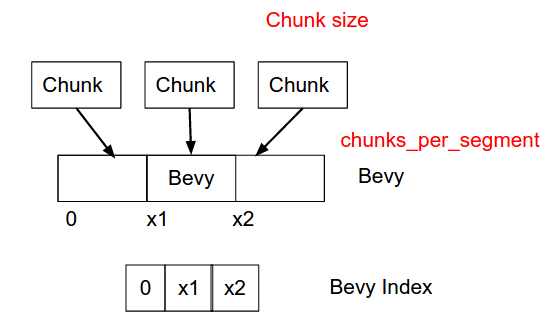The AFF4 Image stream.
The AFF4 Image stream is the workhorse of AFF4 forensic images. It is designed to efficiently store a large quantity of compressed data while still making it fast to access the data randomly.
The image data is divided in chunks. Each chunk is compressed separately. A number of chunks are collected into a single segment termed a bevy. Each bevy also has another segment called the bevy index which contains the start offset of each compressed chunk inside the bevy.
The bevy URN is derived from the AFF4 Image URN by appending an 8 digit decimal, zero padded bevy id (an incrementing integer started from 0). Each bevy’s index has a URN which is created by appending “/index” to the bevy’s URN.
For example, for an Image with URN aff4://05d7e827-5a23-4c17-97d5-190542e05b92/dev/sda1, the third bevy will be named aff4://05d7e827-5a23-4c17-97d5-190542e05b92/dev/sda1/00000002 and the third bevy’s index will be namedaff4://05d7e827-5a23-4c17-97d5-190542e05b92/dev/sda1/00000002/index.

AFF4 Image properties
AFF4 Image objects are suitable for writing large quantities of contiguous data - for example a disk image. Note that when writing the stream, it is not possible to seek in the stream and that AFF4 Image streams are not sparse. The stream is also not encrypted or authenticated.
AFF4 Image implementations may cache some of the chunks to avoid decompressing frequently accessed chunks.
Information model
Note that an AFF4 Image stream does not need to be stored in a single volume - it may be split across multiple volumes. The AFF4 Image does not actually use the http://aff4.org/Schema#stored predicate at all. The resolver attempts to locate the segments which make up the AFF4 Image, and therefore only needs to know where the segments themselves are stored. The AFF4 Image object is not itself stored in any single volume.
| Predicate | Description |
|---|---|
| http://www.w3.org/1999/02/22-rdf-syntax-ns#type | The type of object. For AFF4 Image objects this will be the URN http://aff4.org/Schema#image . |
| http://aff4.org/Schema#chunk_size | The (uncompressed) chunk size in bytes. This defaults to 32kb. Note that the last chunk may be shorter. |
| http://aff4.org/Schema#chunks_per_segment | How many chunks should be collected into a single bevy. Note that the last bevy may contain fewer chunks. |
| http://aff4.org/Schema#compression | How the chunks are compressed. Currently supported are https://www.ietf.org/rfc/rfc1950.txt (i.e. zlib.compress). |
Example
In the following example we acquire a disk image into a new volume:
$ aff4imager -i /dev/sda1 -o /tmp/test.aff4 -t
Adding /dev/sda1
$ aff4imager -V /tmp/test.aff4
@prefix rdf: <http://www.w3.org/1999/02/22-rdf-syntax-ns#> .
@prefix aff4: <http://aff4.org/Schema#> .
@prefix xsd: <http://www.w3.org/2001/XMLSchema#> .
<aff4://05d7e827-5a23-4c17-97d5-190542e05b92/dev/sda1>
aff4:chunk_size 32768 ;
aff4:chunks_per_segment 1024 ;
aff4:compression <https://www.ietf.org/rfc/rfc1950.txt> ;
aff4:size 770786816 ;
aff4:stored <aff4://05d7e827-5a23-4c17-97d5-190542e05b92> ;
a aff4:image .
$ unzip -l /tmp/test.aff4
Archive: /tmp/test.aff4
aff4://05d7e827-5a23-4c17-97d5-190542e05b92
Length Date Time Name
--------- ---------- ----- ----
439 2015-02-24 17:06 information.turtle
13859347 2015-02-24 17:06 dev/sda1/00000001
4096 2015-02-24 17:06 dev/sda1/00000007/index
4096 2015-02-24 17:06 dev/sda1/00000010/index
4096 2015-02-24 17:06 dev/sda1/00000000/index
4096 2015-02-24 17:06 dev/sda1/00000009/index
3980 2015-02-24 17:06 dev/sda1/00000022/index
7191448 2015-02-24 17:06 dev/sda1/00000015
4096 2015-02-24 17:06 dev/sda1/00000017/index
4096 2015-02-24 17:06 dev/sda1/00000008/index
4096 2015-02-24 17:06 dev/sda1/00000019/index
....
